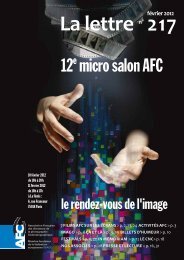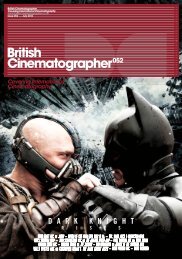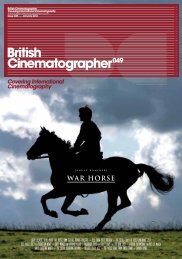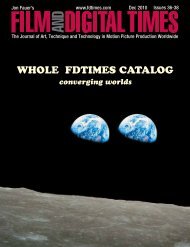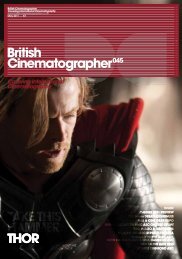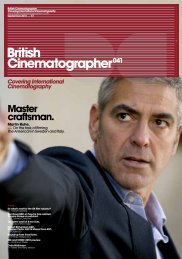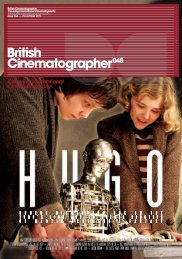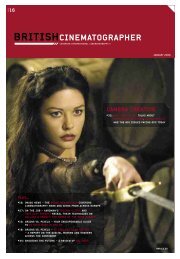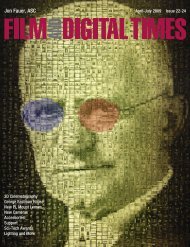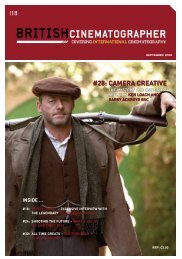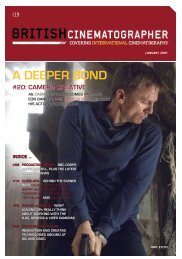British Cinematographer issue 51 - Imago
British Cinematographer issue 51 - Imago
British Cinematographer issue 51 - Imago
Create successful ePaper yourself
Turn your PDF publications into a flip-book with our unique Google optimized e-Paper software.
<strong>British</strong> <strong>Cinematographer</strong><br />
Covering International Cinematography<br />
www.britishcinematographer.co.uk<br />
Issue 0<strong>51</strong> ––– May 2012 40<br />
41<br />
<strong>British</strong> <strong>Cinematographer</strong><br />
Covering International Cinematography<br />
www.britishcinematographer.co.uk<br />
Issue 0<strong>51</strong> ––– May 2012<br />
Grains vs Pixels<br />
–––Nic Morris BSC<br />
Generations shot on Sony F65<br />
Dolly... Nic Morris BSC getting to<br />
grips with the F65.<br />
With a working title of Generations, Morris with the<br />
support of Philippe Ros AFC, shot a short film intended to<br />
show off the capabilities of the F65, which was screened<br />
at NAB 2012 using a 4K projector. The story is based<br />
around a car being passed down through a family,<br />
encompassing scenes in the 1920s, the 1960/70s and<br />
the present day. According to Morris, who has extensive<br />
experience in both high-end digital acquisition, 35mm<br />
and 65mm, the film came together really quickly: “We<br />
assembled a good team and Peter Farrer the director<br />
came up with a really nice, simple story that worked<br />
without language.”<br />
Morris (Being Human, Spooks and features including<br />
Firelight for Buena Vista) and Farrer were keen to give<br />
each of the periods a look of their own. “It allowed us<br />
to start the film with the old Academy square of 1.37:1,<br />
and with a semi black and white, duotone type feel,”<br />
explains Morris. “Then we went to a period in the ‘60s<br />
with the 2.4:1 wide screen and that strong Technicolor<br />
look. The rest of the film is present day with 16:9 and<br />
more muted, cooler tones. I think it was useful in a film<br />
such as this to show that the camera was malleable and<br />
could achieve different looks. As cinematographers we<br />
want to take the camera’s RAW material and tell the<br />
stories we want to tell. So it’s not just a technical exercise<br />
in recording what’s in front of us.”<br />
Setting the look for the film was aided by having a<br />
Baselight grading suite on set. “At the end of the day<br />
we could ingest the footage off the 1TB cards from<br />
the F65’s SR-R4 recorder, and release the cards back<br />
to the camera,” says Morris. “It also gave us the luxury<br />
of starting to look at the pictures while we were still<br />
shooting. That’s very useful because your colour memory<br />
is only a few hours old at the most. You can then take it<br />
into the suite.”<br />
Our roving reporter<br />
Michael Burns recently had<br />
the pleasure of watching<br />
Nic Morris BSC at work<br />
on a promotional film for<br />
Sony, shooting around<br />
Coniston Water in the Lake<br />
District, putting the new<br />
4K-capable Sony F65 digital<br />
cinematography camera<br />
through its paces.<br />
But it’s unusual to have such a full solution on set.<br />
“We do have rough grading setups on set which allow<br />
the DP to put a look-up table into the rushes,” says Morris.<br />
“I think it’s going to become mainstream with these kinds<br />
of cameras which just produce RAW footage. The RAW<br />
footage is the basic score if you like, while the look-up<br />
table is the conductors interpretation of the piece.”<br />
Morris is no stranger to digital, being one of the<br />
early adopters of HD for commercials. He says he has<br />
‘no emotional baggage with film’, but equally has a<br />
keen eye for the technical differences between the<br />
formats, especially film’s ability to capture shadow<br />
detail in low light: “Talking about cinema more than<br />
television, when you have a low-key scene, a really<br />
dark scene, with film you can really produce prints that<br />
are very rich and very detailed. You can get fantastic<br />
texture and quality - it’s not just a big blob of dark grey.<br />
And I think that’s always been the hardest thing for<br />
digital to do - it tends to go a bit muddy.”<br />
“The F65 is slightly different from other cameras in<br />
terms of how the exposure is judged,” Morris continues.<br />
“On the first test day, I did some shooting in some real<br />
low light levels, with some fantastic shadow detail. I<br />
got really excited about it. For the first time [on digital],<br />
something reminded me of a film camera with Primo<br />
lenses, which for me is a benchmark for really beautiful<br />
texture and quality in the shadows. The camera does<br />
have a really wide dynamic range, it’s just how you work<br />
that and how that gets used further down the line that’s<br />
perhaps the interesting part.”<br />
Another key requirement of course is resolving<br />
power. “Up in the Lake District, there were lots of<br />
drystone walls and the trees didn’t have their leaves on<br />
yet, so there were a lot of filigree branches going off<br />
into the sky,” he recalls. “[Shooting on the F65] was an<br />
absolute delight – the resolution was like using a 10x8<br />
plate camera. The texture in those stone walls and the<br />
texture in the branches absolutely came alive. That’s<br />
something I’ve not seen in another digital camera and<br />
it’s normally something you’re more likely to see shooting<br />
on 65mm. It’s not just the raw shapes of the landscape<br />
that work, but also the texture of the bracken and in the<br />
drystone walls.”<br />
“We were also running new Cooke 5/i and new<br />
[Summilux-C] Leica lenses,” he says. “These are very<br />
high resolving lenses. And it’s only now that you have<br />
a camera of this quality that you’ll be able to see what<br />
these lenses can do.”



